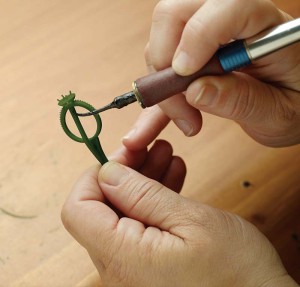Mulling your choices
Mill versus printer? Which one do you choose? Some might consider buying both, depending on their business and production needs. But which should you buy first? A short tutorial is in order.
What is milling?

Milling—also known as computer numerical control (CNC)—is a cutaway process that has been around for more than 100 years. Imagine a sculptor using a mallet and chisel to chip away at a stone block into the desired shape, only with milling machines, the block is actually wax and the tools are carbide cutters (i.e. drill bits). Jewellers can choose from several milling machines based on their needs.
Three-axis machines start at about $1500 and are good for cutting flat objects. The machine moves side to side, forward and backward, and up and down. If your business is primarily charms or coins, a three-axis machine is all you need. However, if you are using a mill to produce rings, you may want to consider a four-axis machine, since it rotates the wax as it is being cut. This technology can range from $3000 to $25,000.
A five-axis machine can clear out more wax than a three- or four-axis mill. Describing a five-axis milling machine requires audience participation. Hold up your left hand and make a fist. Using your right hand, place a finger perpendicular to your fist. Now rotate your left wrist. Whichever direction it moves, keep your finger on your fist. Notice the different angles of your fist in relation to your finger. Although this technology typically starts at $70,000, some manufacturers are working to get an accurate five-axis machine into the jewellery market for less than $20,000. In general, most custom shops would use a four-axis machine, due to price. (The software alone for a five-axis machine is well over $10,000.) In order to justify the cost of a $20,000 four-axis mill, a company would need to cut more than six waxes a month.
Can a mill cut gold?
There are different classes of mills. Some are built to cut wax, while others cut metal. If your purpose is to cut metal, keep in mind that gold is actually ‘sticky’—a thin piece of gold can wrap itself around a cutting tool. In addition, there is some loss of gold depending on the metal thickness.





